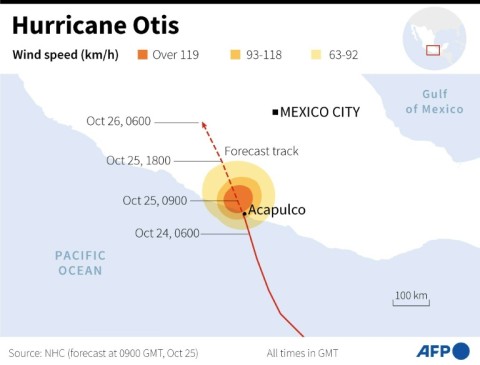NEW MEXICO - Hurricane Otis weakened to a Category 2 storm after making landfall near Mexico's Pacific beach resort of Acapulco on Wednesday, though it was still generating flash flooding and "extremely destructive winds," US forecasters said.
President Andres Manuel Lopez Obrador said that there were no initial reports of deaths after Otis came ashore during the night as a "potentially catastrophic" Category 5 hurricane.
"There's material damage and blocked roads. The highway to Acapulco has landslides," he said at his morning news conference, adding that communications in the region were difficult.
Maximum sustained winds slowed to around 175 kilometers per hour as the storm moved inland, down from 165 miles per hour when Otis hit the coast, the US National Hurricane Center (NHC) said.
"Damaging hurricane-force winds will spread inland over southern Mexico this morning with extremely destructive winds near the core during the next few hours," it warned.
The storm had rapidly strengthened to the most powerful category of the five-step Saffir-Simpson scale as it neared land, taking authorities by surprise.
"Rarely, according to records, does a hurricane develop so quickly and with such force," Lopez Obrador said.
On Tuesday night, the Mexican president had appealed on social media for people to move to emergency shelters and away from rivers, streams and ravines.
- Tourists take shelter -
At dawn, much of Acapulco, a city of about 780,000 inhabitants in Guerrero state, was still without power and communications were patchy.

Videos posted on social media showed shattered windows and tourists using beds and mattresses as protective barriers in their hotel rooms, while others took refuge in bathrooms.
Before the storm hit, many people bought last-minute supplies of food and water, with some business and homeowners boarding up their windows.
More than 500 emergency shelters were opened for residents.
Forecasters said rainfall of up to 51 centimeters was expected across Guerrero and parts of neighboring Oaxaca -- two of Mexico's poorest states, home to remote mountain communities.
"This rainfall will produce flash and urban flooding, along with mudslides in areas of higher terrain," the NHC warned.

Hurricanes hit Mexico every year on both its Pacific and Atlantic coasts, usually between May and November, though few make landfall as a Category 5.
In October 1997, Hurricane Pauline hit Mexico's Pacific coast as a Category 4 storm, leaving more than 200 people dead, some of them in Acapulco.
It was one of the deadliest hurricanes to batter Mexico.
In October 2015, Patricia became the most powerful hurricane ever recorded, pummeling Mexico's Pacific coast with sustained winds of 200 miles per hour.
But the storm caused only material damage and no deaths as it made landfall in a sparsely populated mountainous area.
Just this week, Tropical Storm Norma left three people dead, including a child, after making landfall for a second time in the northwestern state of Sinaloa.
Earlier this month, two people died when Hurricane Lidia, an "extremely dangerous" Category 4 storm, struck the western states of Jalisco and Nayarit.
And in August, storm Hilary, which at one point was also a Category 4 hurricane, caused one death and damaged infrastructure when it hit Baja California.
Scientists have warned that storms are becoming more powerful as the world gets warmer with climate change.
By Aurora Harrison


